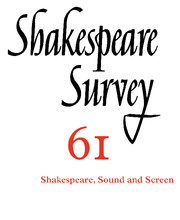Book contents
- Frontmatter
- Sarah Siddons, theatre voices and recorded memory
- Playing with Shakespeare’s play: Branagh’s Love’s Labour’s Lost
- Bottom and the gramophone: Media, class and comedy in Michael Hoffman’s A Midsummer Night's Dream
- Maurice Evans’s Richard II on Stage, Television and (Almost) Film
- Richard II on the Screen
- ‘Where Lies Your Text?’: Twelfth Night in American Sign Language Translation
- ‘This uncivil and unjust extent against thy peace’: Tim supple’s Twelfth Night, or what violence will
- ‘There’s no such thing’: nothing and nakedness in Polanski’s Macbeth
- Ghosts and mirrors: the gaze in film Hamlets
- ‘Ben, it’s a terrible thing to hate your mother’: mind control in Hamlet and The Manchurian Candidate
- Channelling the ghosts: the Wooster Group’s remediation of the 1964 Electronovision Hamlet
- Listening to Prospero’s Books
- Lend Me Your Ears: Sampling BBC Radio Shakespeare
- An Age of Kings and The ‘Normal American’
- Shakespeare and British Television
- A Local Habitation and a Name: Television and Shakespeare
- Paying attention in Shakespeare parody: from Tom Stoppard to YouTube
- Madagascan will: cinematic Shakespeares / transnational exchanges
- Still life? Anthropocentrism and the fly in Titus Andronicus and Volpone
- Riddling q1: Hamlet’s mill and the trickster
- ‘Speak, that I may see thee’: Shakespeare characters and common words
- Who do the people love?
- A Partial Theory of Original Practice
- Shakespeare Performances in England, 2007
- Professional Shakespeare productions in the British Isles, January–December 2006
- The Year's Contributions to Shakespearian Study 1 Critical studies
- 2 Shakespeare in performance
- 3a Editions and textual studies
- 3b Editions and textual studies: The RSC Complete Works
- Index to Volume 61
Ghosts and mirrors: the gaze in film Hamlets
Published online by Cambridge University Press: 28 November 2008
- Frontmatter
- Sarah Siddons, theatre voices and recorded memory
- Playing with Shakespeare’s play: Branagh’s Love’s Labour’s Lost
- Bottom and the gramophone: Media, class and comedy in Michael Hoffman’s A Midsummer Night's Dream
- Maurice Evans’s Richard II on Stage, Television and (Almost) Film
- Richard II on the Screen
- ‘Where Lies Your Text?’: Twelfth Night in American Sign Language Translation
- ‘This uncivil and unjust extent against thy peace’: Tim supple’s Twelfth Night, or what violence will
- ‘There’s no such thing’: nothing and nakedness in Polanski’s Macbeth
- Ghosts and mirrors: the gaze in film Hamlets
- ‘Ben, it’s a terrible thing to hate your mother’: mind control in Hamlet and The Manchurian Candidate
- Channelling the ghosts: the Wooster Group’s remediation of the 1964 Electronovision Hamlet
- Listening to Prospero’s Books
- Lend Me Your Ears: Sampling BBC Radio Shakespeare
- An Age of Kings and The ‘Normal American’
- Shakespeare and British Television
- A Local Habitation and a Name: Television and Shakespeare
- Paying attention in Shakespeare parody: from Tom Stoppard to YouTube
- Madagascan will: cinematic Shakespeares / transnational exchanges
- Still life? Anthropocentrism and the fly in Titus Andronicus and Volpone
- Riddling q1: Hamlet’s mill and the trickster
- ‘Speak, that I may see thee’: Shakespeare characters and common words
- Who do the people love?
- A Partial Theory of Original Practice
- Shakespeare Performances in England, 2007
- Professional Shakespeare productions in the British Isles, January–December 2006
- The Year's Contributions to Shakespearian Study 1 Critical studies
- 2 Shakespeare in performance
- 3a Editions and textual studies
- 3b Editions and textual studies: The RSC Complete Works
- Index to Volume 61
Summary
In this article I use the sense of rupture implicit in Jacques Lacan’s theory of the gaze to explore film adaptations of Hamlet. My discussion focuses on three well-known adaptations of the play: Olivier, Branagh and Almereyda. I particularly employ Slavoj Žižek’s conception of Lacan’s ‘anamorphic stain’, and Henry Krips’s reading of the points of rupture of the gaze to investigate the symbiotic relationship between the demands Shakespeare’s text makes on film-production, and filmmakers’ manipulation of libidinal-looking in conceiving diegetic space. My contention, that negotiation of concretized film space is the central issue to be confronted in the adaptation of Shakespeare to the genre codes of film, directs my attention to instances of what I term ‘liminal space’, sites of apparent filmic resistance to the concrete (visually defined, realistic, photographic, naturalistic) space of the film diegesis. Though psychoanalytic theory is central to my paper, I attempt to address the recent ‘post-Theory’ theses proposed by Bordwell et al., by grounding theory always in discussion of filmic style, directorial technique and the various signifiers that compose the screen image.
MIRROR TRICKS AND SPECTRAL PRESENCES
To hold, as, ’twere, the mirror up to nature . . .
(3.2.21–2)At the very opening of the era of cinema, theatrical productions begin to incorporate a series of special effects that uncannily seem to anticipate the future of new form – partially due to technological advances, and partly in order to maintain interest in customers wooed by forerunners to the silver screen. ‘Pepper’s Ghost’, the use of two reflective screens of glass to make a ghost appear on stage, was developed by Henry Dircks in 1862 and perfected for theatrical use by Henry Pepper towards the end of the nineteenth century. The technique required that a second stage be constructed beneath the actual stage, and two reflective screens of glass put into place, the first set at a ninety-degree angle above the lower stage, the second in front of it.
- Type
- Chapter
- Information
- Shakespeare Survey , pp. 116 - 133Publisher: Cambridge University PressPrint publication year: 2008



